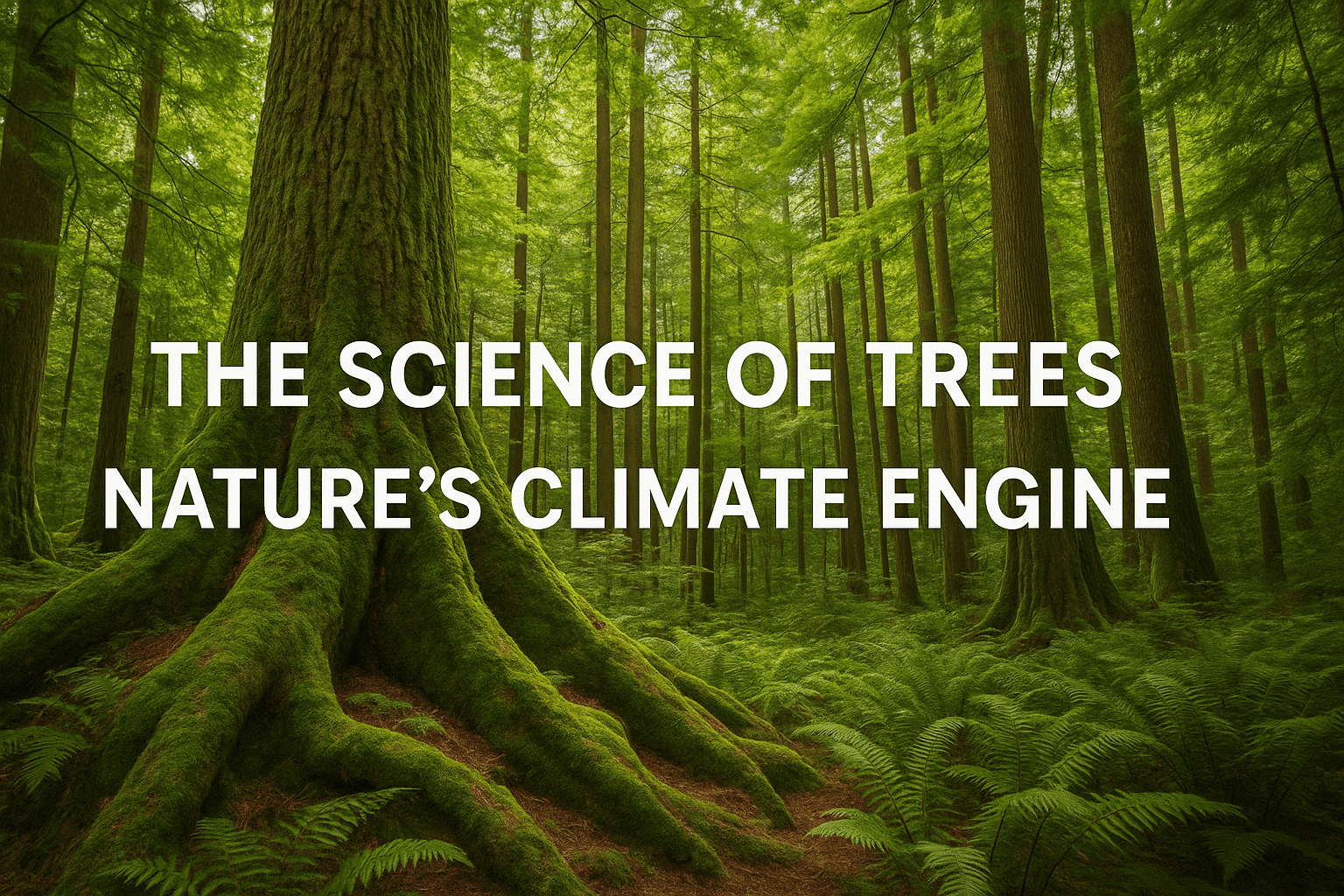We walk past them every day. They shade our sidewalks, dot our parks, and frame our skylines. But trees — those silent, towering beings — are far more than decorative backdrops to urban life. They are living, breathing machines, tirelessly working as nature’s most efficient climate regulators. In this blog, we’ll explore how trees operate at both a microscopic and global scale, how they interact with other organisms, and why their role in fighting climate change is both essential and underappreciated.
A Tree is a Living System
At first glance, a tree seems simple. Trunk, branches, leaves. But inside, it’s a marvel of evolutionary engineering. Trees are vascular plants, meaning they have specialized tissues to transport water, nutrients, and sugars throughout their bodies. These tissues — xylem and phloem — operate like biological plumbing systems.
The xylem transports water and minerals from the roots to the leaves. The phloem carries sugars made during photosynthesis in the leaves down to the roots. This transport system is so efficient that water can travel over 300 feet vertically in some species like the coastal redwood.
But perhaps most remarkably, all of this movement occurs without a pump. Instead, trees rely on capillary action, root pressure, and transpiration — the evaporation of water from leaves — to keep the system running. This passive hydraulic lift is an elegant, silent process that’s been working perfectly for hundreds of millions of years.
Trees and the Carbon Cycle
Trees are crucial players in Earth’s carbon cycle. During photosynthesis, they absorb carbon dioxide (CO₂) from the atmosphere and, with the help of sunlight and water, convert it into glucose and oxygen. A single mature tree can absorb about 48 pounds of CO₂ each year.
Globally, forests absorb roughly 2.6 billion tons of CO₂ annually — about one-third of the CO₂ released from burning fossil fuels. This ability to sequester carbon makes trees a frontline defense in the fight against climate change.
Yet, deforestation and forest degradation continue to be a major concern. The Amazon, often called the “lungs of the Earth,” is nearing a tipping point where it could turn from a carbon sink into a carbon source due to logging, fire, and agricultural encroachment.
Microclimate Regulators
Trees don’t just regulate the climate at the planetary level; they do it right in your neighborhood. Urban trees can lower ambient temperatures by up to 9°F (5°C) through a process known as transpiration cooling. As water evaporates from the leaves, it cools the surrounding air.
This isn’t just about comfort — it’s about public health. Urban heat islands disproportionately affect low-income communities, increasing the risk of heat stroke, respiratory issues, and even death during extreme heatwaves. Trees serve as natural air conditioners, especially critical as global temperatures rise.
Trees and Biodiversity
A single oak tree can support over 500 species of insects, birds, fungi, and mammals. Trees provide habitat, food, and breeding grounds for everything from squirrels and owls to lichens and butterflies.
In tropical rainforests, trees form complex ecological networks. The canopy, understory, and forest floor each support unique ecosystems, all interconnected through food webs and nutrient cycles. When a single tree falls, it can create a ripple effect, affecting dozens of species.
Recent studies even suggest trees may communicate. Through a network of mycorrhizal fungi — dubbed the “wood wide web” — trees share nutrients and chemical signals with one another. A mother tree may direct sugars to a sapling in distress. It’s not a metaphor — it’s a mycological fact.
Deforestation: The Hidden Costs
We often hear about deforestation in terms of lost acreage. But the costs go deeper. When a forest is cleared, we lose:
- Carbon storage: Trees that once locked carbon now release it into the atmosphere.
- Water regulation: Forests maintain the hydrological cycle. Removing them disrupts rainfall patterns.
- Soil integrity: Tree roots prevent erosion. Without them, topsoil — the most fertile layer — washes away.
- Cultural identity: Indigenous communities tied to forest ecosystems lose not only livelihood but heritage.
Urban Forestry and Rewilding
The solution isn’t just to protect forests in remote areas. Urban forestry — the practice of planting and maintaining trees in cities — is gaining momentum. Tree-lined streets improve air quality, reduce noise, and even raise property values.
London’s Mayor has pledged to increase tree canopy by 10% by 2050. In Melbourne, Australia, every public tree has an email address — and citizens use them not just to report damage, but to send love letters to their favorite trees.
On a broader scale, rewilding initiatives aim to restore native tree species to landscapes stripped of biodiversity. Projects in Scotland, Kenya, and the U.S. are turning depleted lands into thriving ecosystems.
The Future: Technology Meets Trees
Even forestry is going high-tech. Drones now plant tree seeds in fire-ravaged regions. Satellite imaging monitors forest health in real time. DNA tagging tracks illegal logging.
The idea of “smart forests” is emerging — ecosystems embedded with sensors to track temperature, moisture, and CO₂ absorption. These living labs could shape climate policy, forestry management, and urban planning.
Final Thoughts: Reverence, Not Just Conservation
Protecting trees is not simply a scientific or environmental issue. It’s a moral one. Trees predate humanity by hundreds of millions of years. They have shaped our air, our soil, our culture, and our collective imagination.
They appear in our myths, our religions, our art. From the Tree of Life in ancient Mesopotamia to the Bodhi tree under which the Buddha found enlightenment, trees have always stood as symbols of endurance, wisdom, and renewal.
So the next time you stand beneath a tree, look up. You’re not just looking at a plant — you’re standing beneath one of Earth’s most ancient and powerful systems. A system that asks for nothing but gives us everything.

